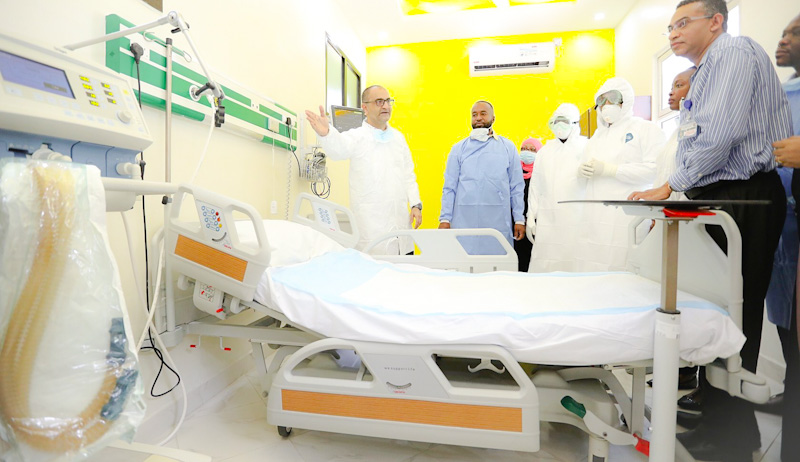The ultimate treatment of endometriosis is removing the abnormally located tissue, known as excision surgery.
This is a delicate operation that aims to balance the restoration of normal function and minimisation of risk due to inadvertent damage to normal organs.
Endometriosis has gained much prominence in both lay and professional discourse over the past three decades. This has seen the formation of patient advocacy groups and the development of treatment guidelines by professional associations globally, whose culminations are the World Endometriosis Organization (WEO) and the World Endometriosis Society (WES) respectively.
Locally, the Endometriosis Foundation of Kenya sits on the steering committee of the WEO. The unique partnership between patient and professional bodies in endometriosis discussions guarantees that a common agenda in the management of endometriosis is pursued for the betterment of the patients.
As more understanding of endometriosis is gained through continued research and observation, a recommendation for the type of surgical management also changes.
It is recommended that excision surgery is performed by trained specialists to reduce the risk of complications that may be associated with an operation and the risk of multiple surgeries.
Patients with severe endometriosis must be treated in a centre with a multidisciplinary team of specialists. This team comprises a gynaecologist trained in endometriosis surgery, a bowel surgeon, and a urologist.
Other members include a radiologist with a special interest in female reproductive imaging, a pain management specialist, a fertility specialist, a counselling psychologist, and a physiotherapist.
Patients with severe endometriosis must be treated in a centre with a multidisciplinary team of specialists. This team comprises a gynaecologist trained in endometriosis surgery, a bowel surgeon, and a urologist.
Other members include a radiologist with a special interest in female reproductive imaging, a pain management specialist, a fertility specialist, a counselling psychologist, and a physiotherapist.
Whereas the extent of endometriosis may vary and dictate the complexity of the disease and the surgery, inadequate preoperative assessment of a patient may result in an unexpected finding of severe disease at the surgery which was not anticipated.
This could result in inadequate treatment as the patient may not have been adequately counselled and consented to complex surgery, or the surgeon may be untrained to handle this.
Patients present to doctors with various symptoms, more commonly with pain or infertility. A thorough assessment with particular attention to the pain character, and examination to pick out areas of disease involving the bowel, ovaries and roof of the vagina will guide the clinician to the extent of the disease.
An initial test tends to be a pelvic ultrasound scan. This is best performed using a transvaginal probe preferably by the gynaecologist if trained.
The focus should be on detecting disease in the ovaries which present as a cyst (fluid-filled sac), disease behind or in front of the uterus and between the rectum and vagina. Often, an ultrasound assessment is adequate, however, a more sophisticated test known as magnetic resonance imaging (MRI) may be requested.
Findings of severe disease on MRI require that a multidisciplinary team meeting is convened to carefully plan the surgical operation combining guidance from the radiologist and surgical expertise.
The decision of the multidisciplinary team will usually be communicated to the patient by the lead gynaecologist, who ensures that the patient fully understands the planned surgery, including benefits, risks or alternatives to the treatment. Only a well-informed patient should proceed to surgery.
Understanding may be enhanced by using a patient information leaflet that distils complex medical information into clear and easy-to-understand language. Patients are encouraged to bring a relative or trusted friend to the appointment when discussing with the doctor and must never be hurried to decide on going into surgery.
Generally, laparoscopy is preferred to open surgery as it confers added benefits such as better visualisation and access for surgery, less pain and quicker recovery for the patient and if well done, it becomes economical in the long term.
Laparoscopy involves passing a special operating telescope through the belly button (navel) and using long instruments through small incisions in the abdomen to operate. The image is usually projected onto a high-definition television screen. Some equipment is enabled to record the operation which can be reviewed later.
Often, this type of operation takes longer to complete as it involves taking away diseases that may be near or on vital organs such as the bladder, ureter (tube connecting kidney and bladder), or bowel. When the ovary contains a cyst, this has to be removed with meticulous attention to detail ensuring that normal tissue is not destroyed which may result in ovarian failure.
An ovarian cyst also signifies the presence of severe disease, and this must be emphasised as removing the cyst and leaving the disease elsewhere means symptoms are likely to persist.
Accomplishing a complex operation is not enough, and a careful follow-up plan must be drawn by the specialist keeping the wishes of the patient at the centre of discussions.
Evidence is now accumulating that a competently done operation achieves high pain relief scores and improved fertility outcomes. Working closely with other specialists, such as counselling will improve outcomes as often the patient may have struggled for a long time before getting the correct diagnosis or proper surgery.
By Dr Charles Muteshi, Endometriosis and Fertility Specialist, Aga Khan University Hospital Nairobi




